#moroccan legacy
Explore tagged Tumblr posts
Text
i want to learn how to play the violin so bad
#my dad and his side of the family are all very good violinists so i feel like i need to continue the family legacy#also i'm moroccan so there's that
0 notes
Note
Omg I started reading your fics and I fell in love😭
I wanted to request a Rafe x reader (angst) where like she's Kiara older sister but she dies instead of JJ, and its all angst and something like that 🥲
(its okay if you don't want to write this!💋)
Love you!!! 💓
𝗽𝗶𝗻𝗸𝘆 𝗽𝗿𝗼𝗺𝗶𝘀𝗲 [𝗿𝗮𝗳𝗲 𝗰𝗮𝗺𝗲𝗿𝗼𝗻]



first request yay !! i’m new to writing on tumblr, so here’s my first one! excited to do more <33
pairing - rafe x pogue!carrera!reader
warnings - angst, hurt, sad asf, reliving jj’s death but plot twist it’s you this time, cursing, death
summary - ask above ↑ you’re kiara’s older sister. (rafe’s age gap to sarah is what i imagined!). when you’re in morocco on a dangerous trip to help your friend jj get answers, everything goes terribly wrong. in a last stitch effort to save your best friend and sister, you end up clinging for life in your boyfriend’s arms with your friends beside you.

i can’t see anything. my arm covers over my eyes as dust blows in every direction. the hot air coats my skin covered by cloth.
“rafe!” i shout, trying to see, trying to find him. he ran off with john b and sarah. and now, i couldn’t find him.
that’s when i see my sister, and jj.
i stand back, dodging behind a wall so groff wouldn’t see me. my hand covers my mouth in shock as i see groff holding a knife to my sisters neck. “shit.” i mutter.
“give me the crown, and you can have the girl.” groff says, sticking his arm out gingerly, while holding kiara close to his chest.
“okay, okay, you can have it. just give me kiara.” jj says, raising his hands in defense.
i try to watch through the dusty sandstorm as jj reluctantly and carefully trades the crown for kiara. they both switch hands at the same time, kiara collapsing in jj’s arms.
groff holds the crown to his chest, a sick smirk on his face. his eyes flick to the knife in his hand, then back at jj.
no. no. no.
before i can even think, my feet are moving before my mind could. through the blazing heat and thick sand storm, i move blindly. going in the direction of kie and jj, i slot myself between jj and groff.
i gasp, my hand coming to my stomach. my eyes are locked onto groff’s and he raises his eyes in surprise.
“y/n!” i hear the desperate pleas of my sister fade into blurry obscurity. i couldn’t recount every moment after that. it was all a blur of pain.
my breathing is heavy, but fast. kiara had propped me up against a weak wooden pillar.
“y/n! it’s gonna—gonna be okay? okay?” kie says, her voice shaking. i could barely hear her over the roaring winds around us. jj was kneeling next to kie in front of me. he wasn’t saying a word. he was in shock, staring at the blood beginning to stain the moroccan cloth clothing cleo stole for all of us.
the blood that was supposed to coming from his own abdomen, was now instead, on his hands. i furrow my eyebrows at him, silently pleading for him to not feel guilty. i shake my head.
“it’s okay.” i whisper weakly.
jj’s eyes were full of guilt, regret, and anger. this would kill him. the survivors guilt. and i knew kiara would be fueled by anger and revenge.
after everything we went through on this trip, to get here. to save jj’s family legacy. to get him answers. and to save what was rightfully ours on kildare, the surf shop.
instead of leaving in riches, smiles on our faces—i would never leave. and my friends would all leave with vengeance in their hearts, and no place to go home to.
as i think about my friends, all the pogues—my mind goes to my boyfriend. the one kook with us. and suddenly, my heart is ripped in two.
my eyes immediately meet jj’s. weakly, i plead. “find rafe. please.”
jj nods firmly without a second’s thought. he stands, pulling the bandana over his nose and finding rafe.
“kie.” i whisper, my voice weak as my lip quivers. i look at my sister who’s hands were pressing harshly against my stomach, trying to stop the bleeding.
“no, no it’s fine—you’re fine!” she exclaims as tears violently and rapidly soar down her cheeks.
“hey.” i say, getting her attention.
finally, her glassy eyes move from my stomach to my face, a sob escaping her lips.
“i love you, kie, okay?” i sniffle. “save a seat for me at the maybank wedding, hm?” i tease with a weak chuckle.
“shut up.” she says through gritted teeth, hot tears never stopping. “i won’t have to. cause you’ll be there. cause you’re my sister-you-you’re supposed to be there.”
“okay.” i whisper with a weak nod.
she presses her lips together, closing her eyes. she hears the agreement and compromise in my single word response because, i didn’t want to argue. even if it was a stupid, little argument about her adamance of my survival. my last moments with my sister couldn’t be ended in trivial bicker.
“i love you too.” she whispers.
“y/n?!”
i look up, seeing rafe rushing toward us with an urgency i’ve never noticed him have before. jj trailed behind, john b, sarah, cleo, and pope following suit.
“baby.” rafe whispers. he kneels next to me, moving my body slightly so my back laid against his chest. kie still knelt in front of me, her hands holding pressure on my stomach.
i tilt my head back slightly as i look up at rafe. “hi.” i whisper weakly.
he pulls his bottom lip between his teeth, shaking his head. “no. no, no, you’re not goin’ anywhere, alright? we-we’ve talked about this. you can’t go before i do.”
“tell that to groff.” i wince, groaning as i lean against him. “fuck.” i mutter in pain.
“i’m gonna fuckin’ kill that bitch.” rafe spits. i look up at him, and see tears falling down his cheeks.
my hand weakly reaches up, pulling down the bandana from his nose. “hey.” i whisper softly, my touch gentle as my thumb wipes his tears. “i’m gonna be fine.”
my eyes dart down at my sister. “right, kie?”
her lip quivers violently, she presses harder against my stomach. then, her eyes look up at rafe.
even though my sister and all of my friends hate rafe—they understand. they see how much he cares about me. ever since we started dating, parts of them had grown slightly tolerant to him. because when he’s around me, he’s a little nicer. a little sweeter.
and they know that even if they don’t trust him, i do. and rafe has shown it time and time again. that he cares about me. for real.
“yeah, rafe.” she whispers, her voice shaking. “she’s gonna be fine.” kie says, but i don’t even think she believes the words anymore.
“y/n…” john b says, his lips gaping open. sarah stood beside him, her hand covering her mouth. “oh-oh my god.”
“no, no.” rafe snaps. “don’t say that!” his voice is firm and sharp. “she’s gone be fine! go get help don’t just stand there and gasp—“
“hey, hey.” i say softly, my hand brushing against his cheek. “stop.” i whisper.
john b nods. “no, he’s right. we-we’ll go find help.” john b grabs sarah’s hand as they run off, searching for help. pope looks back reluctantly, but i nod at him. both him and cleo follow to find help. but there was no one for miles. we were screwed.
“you can’t leave me, alright?” rafe gasps, his voice breaking. “everyone else in my life, they always fuckin’ screw me over. yo-you’re the only one i can trust.”
his lip quivers and he leans down, pressing open mouthed kisses to my forehead. “please, baby. you’re all i have, y-you’re everything. c’mon, you-you remember, right?” he sniffles, pulling back and looking down at me.
my eyebrows furrow as i look up at him weakly, letting him continue.
“we gotta buy that house. t-the white one, with the blue shutters on the marsh.” he sniffles. “and you can get all the fuckin’ cats, dogs, bunnies, whatever you want—“
i chuckle softly, clutching my stomach from the pain the laugh causes. rafe and i had been together for about eight months. we’ve talked about moving in together. and there’s this house, on the marsh on figure eight. my dream house. rafe and i always would talk about it and make up scenarios of our future together.
one of them, involved him and i in the backyard of the house as i tend to our many pets. he groaned in annoyance the first time i mentioned it. but, i guess he secretly loved it. he’d do anything for me. anything i wanted, he’d make sure i had it.
“yeah, baby. all the pets. a-and then, i gotta make you mrs. cameron. okay? s-so don’t even think about leavin’ alright? we have so much more-more to do, please.” he begs through shallow cries and gasps.
“okay.” my eyes slowly blink up at him. i weakly bring my hand up, sticking out my pinky. “we’ll have the house, all the pets, and i’ll be mrs. cameron. pinky promise.”
he presses his lips together as a particularly rough sob threatens to escape. his hand comes to mine, his pinky latching on. “pinky promise.” he whispers.
i smile softly at him, then slowly turn my head to kie. “i love you.” i whisper to her.
she nods firmly. “i know. i love you too.”
then, my eyes turn to jj. “it’s not your fault.” i weakly whisper. “thank you, j. for being my best friend. you’re really good at that.” my voice breaks. “p4l?” i chuckle softly.
jj smiles as tears fall down his cheeks. “p4l.” he repeats.
“and, if you break my sisters heart—i’ll haunt you or some shit.” i weakly chuckle. jj grins, a laugh slipping from his lips. his hand comes up, rough knuckles wiping at his tears, he nods. “got it.” he whispers.
i look back up at rafe, leaning further into him, my hand coming up to rest against his chest. “i love you.”
“i know. i love you more. i got you.” he whispers, his voice a ghost now from how low and shaken it is. he presses a kiss to my hair, holding me impossibly close.
i didn’t want to die. but, as my body grew weak, my eyes wanted to close. i just wanted to go to sleep. and part of me hoped that, if i went to sleep, i’d wake up in a few hours magically, in a hospital bed.
maybe john b, sarah, pope, and cleo found help. maybe it’ll be okay.
but if not, i’m okay with that too. i got to go with my favorite people. kiara, my sister. jj, my best friend. and rafe, the love of my life.
as my eyes begin to flutter shut, i take in rafe’s features one last time. my gaze brushes over his blue eyes, the curve of his nose. down to the shadow of his cheekbones, and the purse of his lips that i had gotten the luck to kiss so many times.
i said everything i could’ve possibly wanted to say. i got to die, with the people i loved most in the world. i was okay.
and hopefully, in a few hours, i’d wake up. and get to live a long life with all of them.
but for now, i was going to sleep.
—
damn yall that was sad asf. making me relive jj’s death 😞 hope u enjoyed !! thx for the request lovies !! <3
#rafe cameron#obx fic#rafe obx#rafe cameron imagines#rafe cameron fluff#rafe cameron blurb#outerbanks rafe#rafe cameron smut#drew starkey#protective rafe
264 notes
·
View notes
Text
Joachim Murats descendants in the (Great War) World war 1
1. Louis Napoléon Achille Charles Murat (1872-1943)

A vivid figure from a family known for its colorful characters, Louis Napoléon Achille Charles Murat was the great-grandson of Joachim Murat, King of Naples. He began his military career in the French Army, serving from 1891 to 1903 and rising to the rank of lieutenant in the 9th Régiment de Cuirassiers (Heavy Cavalry) stationed in Noyon.
With maternal roots in Mingrelia (present-day Georgia), Murat’s path took a dramatic turn when he joined the Russian Imperial Army during the Russo-Japanese War. Following the Russian defeat, he remained in service, riding with the Kuban Cossack Regiment from 1905 to 1909, and later serving on the staff of Grand Duke Nicholas Nikolaevich until 1911.
At the outbreak of World War I, Murat was in Argentina. Upon learning of the war’s declaration, he returned to Russia and was assigned to several general staffs. By 1917, he was fighting as a colonel in the 12th Starodubovsk Dragoons. During the Russian Revolution, he joined the White Army, continuing to fight in the Carpathians.
After the civil war, Murat returned to France in 1921, where he made a modest living as a translator. In recognition of his service, he was named a Chevalier (Knight) of the Legion of Honor in 1928. He proudly continued to claim his Russian decorations, including the Orders of Saint Vladimir and Saint George, adorned “with all possible swords and citations.”
He passed away in Nice on June 14, 1943,
2. Alexandre Murat (1889–1926)

Alexandre served as a French artillery officer and a direct descendant of the King of Naples. During World War I, he served as a battery commander and was cited for distinction in combat. His commendation praised him for “obtaining from his battery an excellent performance through the precision of fire which he always directed personally from the most exposed observation posts,” and for maintaining morale and discipline “through his calm demeanor and disregard for danger, even amid heavy losses.”
He was one of eight children of Prince Murat who served in the Great War. Among them, Louis Murat fell at the champ d’honneur (field of honor), and several others were wounded—a remarkable testament to the family’s deep involvement and sacrifice during the conflict.
3.Joachim, 6th Prince Murat (1885-1938)

Joachim began World War I as a cavalry lieutenant. He later commanded the Fort des Sartelles during the Battle of Verdun in 1916, where his exemplary conduct earned him the Croix de Guerre with three citations. Subsequently, he served as an interpreter at the General Headquarters of the Royal Flying Corps, based in Saint-Omer from August 1914 to November 1915. After the war, Murat was elected deputy for the Lot in the 1919 French legislative election and served in the Chamber of Deputies until 1929.
4.Prince Charles Murat (1892–1973):

Cavalryman in the Dardanelles Prince Charles Murat brought the legacy of the Napoleonic cavalry to the battlefields of World War I. Initially serving in the French Army, he was later assigned to the Moroccan Tirailleurs, colonial infantry units known for their fierce combat prowess.
During the Gallipoli campaign in the Dardanelles, Charles fought in brutal close-quarters combat and was wounded in the head. His courage under fire earned him one of France’s highest honors: he was named a Chevalier of the Légion d’Honneur for acts of bravery.
5. Prince Gérôme Murat (1898–1992)

Gérôme took part in numerous operations as a machine gunner with the Salmson, Squadron MF 1, making him an aviator of the Murat family. On February 25, 1918, after an aerial battle over the Vosges, his plane caught fire, forcing him to make an emergency landing. As a result of the incident, he had to have one of his legs amputated.
6. Prince Louis Murat (1896-1916)

A volunteer (registration number 2771/308 - Class 1916), he served as marshal of the houses with the 5th Regiment of Foot Cuirassiers. He went to the front on the night of the 17th to the 18th, in the area of the village of Lihons, on the Santerre plateau in the eastern part of the Somme department, during the Battle of the Somme. He was killed on August 21, 1916, just north of Lihons.
40 notes
·
View notes
Video
youtube
https://www.youtube.com/watch?v=Xih_7N-iLwM
Just yesterday, I had the pleasure of listening to my friend and colleague Judith Cohen describe her ethnomusicological travels, in this case through Canada, Israel, Morocco, and Brazil. She was describing the singers she met who carried on the legacy of Moroccan Sephardi music, often sung in haketia, which is the Moroccan version of Ladino. Songs in haketia are getting rarer, as the Ottoman versions of Sephardi songs have become more popular. But here’s a Moroccan version of Eliyahu HaNavi, in that lovely Moroccan style.
8 notes
·
View notes
Text


Born under the relentless heat of the Moroccan sun, yet raised amidst the rhythmic beats of Jamaican reggae, the man carries the soul of two worlds in his veins. His life has been a journey of embracing contrasts—navigating the dusty, sun-drenched landscapes of the Atlas Mountains and the vibrant, carefree spirit of the Caribbean coast. His tattoos, etched with the intricate geometry of Morocco and the bold symbols of Jamaican freedom, tell the stories of his ancestors, each line a legacy of resilience. With the gold amulet passed down through generations, he stands tall, embodying the strength of his heritage. The desert wind and the ocean breeze have shaped him, merging the spirit of two cultures into one powerful identity. Proud and unwavering, he walks through the world as a living testament to the richness of his roots—an enduring blend of desert heat and island rhythm.
#fantasy ai#ai generated#aiartcommunity#ai artwork#gay pride#ai art#ai art gallery#ai fantasy#fypage#black ai art#gay men#digital art#muscle#muscular#black tumblr#romance#ai#van gogh#anime
7 notes
·
View notes
Text
italian commentators arguing on who's the best colombian player and they were like "james rodriguez" "james rodriguez the best colombian player????" "well I'm not saying so, colombians say so" and the other replied "well I don't know...I didn't expect james rodriguez to be so fundamental to colombia still...since our attention is now on such a talent as luis diaz now" see the culture of the moment, I dislike it so much in football. Luis diaz's a super great player but there's no need to disrespect james rodriguez? he could've had a better career and we all know but he's been a great player and granted I don't know if he's still the most loved colombian player as I'm not colombian, I'm sure there's a reason while he's very much loved and this reason might also be going beyond football (attachment, history, first achievements, pride). It's like what Hakim Ziyech is for us moroccans even tho he's also a player who was a bit unlucky on an international level. Like sometimes you don't have to questions legacy you know, it's not just about playing in the prem and shit
14 notes
·
View notes
Note
Happy WBW! What are some popular hairstyles in your world?
Happy Worldbuilding Wednesday, traveller!✨🌙
Thank you for the question. This has indeed been a fun one.
Here are some Ritual Hairstyles in the Old Lands, as requested~ Not every braid is vanity. Not every veil is silent. In the world of Like Saffron in Sunlight, hair is a language — spoken loudest on the days that matter most.
Here are a few styles worn during sacred moments, drawn from traditions carried by desert caravans and root-keepers alike:
🧵 The Qaws Moon Braid Worn during solstice festivals or rites of blooming, this intricate braid coils around the crown and trails like a falling moonbeam. Silver threads or pearls are woven through it — not for beauty alone, but to invite clarity and protection. (Inspired by Somali and Yemeni bridal braids.)
🌿 The Shayra Veil Wrap Sacred to the healer’s bloodline, this wrap is more than cloth. On naming days and mourning rites, Shayrat like Leila wear richly dyed fabrics tied in a specific pattern over oiled and perfumed hair. The colours signal intention: indigo for mourning, saffron for protection, henna-red for healing. (Think Sudanese toub + Moroccan headwraps.)
🔥 The Ashra Flame Twist Descendants of the Flamebearers twist their hair into thick coils wrapped with copper thread, with the ends singed lightly in ritual. A sign of restraint — and of fire tempered by wisdom. (Loosely inspired by Oromo and Afar ceremonial hair, fused with imagined flame rites.)
🪞 The Mirror Tresses For weddings or diplomacy, nobles from the Old Country oil and press their hair smooth, then part it down the centre and wrap each side into coiled knots near the ears — often fastened with engraved pins or amber stones. It’s a style that whispers legacy, stillness, and control. (Rooted in North African Amazigh and Levantine aesthetics.)
🦚 The Dance of Pins Among the Zumar merchant families, young women perform a coming-of-age dance wearing their hair half-loose, half-pinned with brass combs shaped like birds or leaves. The pins are gifted by elders and passed down across generations.
These aren’t everyday styles. These are the ones remembered. The ones worn when stories are written in the smoke, and the whole town turns to listen.
Which would you wear, traveller — the healer’s veil, the flame twist, or the dance of pins? 🫖
Drop your favourite below — and may your threads never tangle 🌙
#Answered Asks#WorldbuildingWednesday#FantasyLore#MoonlitMinaret#WBW#LSiS#Like Saffron in Sunlight#book writing#authors of tumblr#authors of color#cozy fantasy#original fiction#creative writing#worldbuilding lore#worldbuilding
2 notes
·
View notes
Text
ALGIERS, Algeria (AP) — Algerian lawmakers condemned the European Parliament for a resolution criticizing the arrest of French-Algerian novelist Boualem Sansal.
Lawmakers from both chambers of the North African nation's parliament on Monday signed a statement rebuking the European Parliament's resolution for “misleading allegations with the sole aim of launching a blatant attack against Algeria.”
Since his Nov. 16 arrest, Sansal’s cause has been taken up by European writers, artists and politicians, particularly those on the French right sympathetic to his criticism of Islam.
Sansal has been charged with violating an anti-terrorism statute that rights groups say Algeria uses to target activists and dissidents and quiet criticism of the government. The 76-year-old is among several imprisoned writers mentioned in the European Parliament’s resolution last week, which also references journalist Abdelwakil Blamm and poet Mohamed Tadjadit.
Algerian lawmakers accused the European Parliament of political inference and cast doubt on whether their motivations had to do with Sansal's well-being or “harming the image of Algeria.”
The back-and-forth mirrors similar spats between Europe and nations that were once colonized by some members of the 27-nation bloc and see such criticism as paternalistic. In 2023, Moroccan lawmakers blasted the European Parliament for passing a resolution that implored Morocco to respect press freedoms and grant fair trials to three imprisoned journalists.
The clash over the resolution is the latest rupture between Algeria and France. The countries have for nearly a year sparred over immigration and repatriation issues, the disputed Western Sahara and the legacy of French nuclear testing in Algeria's Sahara Desert, which lawmakers passed a resolution addressing last week.
3 notes
·
View notes
Text
Berber Tattooing: Exploring Amazigh Tattoo Culture and Moroccan Women’s Face Tattoos (Book)
Berber tattoos, also referred to as Amazigh tattoos, serve as a vibrant reflection of the diverse cultural heritage of North Africa's indigenous Berber population. These meticulously crafted and captivating tattoos transcend mere skin-deep artistry; they function as vessels embodying the rich tapestry of heritage, social standing, and personal narratives seamlessly interwoven into the very fabric of Berber identity.
With a historical lineage stretching back millennia, the Berber people have fostered a profound connection with the natural world. Within the realm of Berber tattoos, this deep affinity manifests through a striking array of symbolic depictions, each laden with profound meanings that resonate with life, belief systems, and pivotal moments.
Nature assumes a central role in the realm of Berber tattoos, where symbols bear the imprint of animals, plants, and celestial bodies. The towering palm tree, symbolizing strength, growth, and resilience, serves as a potent representation of life and prosperity deeply ingrained in Berber culture. Likewise, the snake, embodying a guardian spirit, symbolizes wisdom and healing, acting as a protective force against malevolent influences and ushering in good fortune.

Amazon Link: a.co/d/gRSF3Jy
Drawing from ancient Egyptian iconography, the Berber people adopted the Eye of Horus, a potent symbol believed to ward off evil and usher in good luck. Equally significant is the Hand of Fatima, an open palm that serves as a protective talisman against the evil eye and negative energies.
The Amazigh Cross, often referred to as the “Agadez Cross,” serves as a compass of sorts, offering guidance and orientation during travels and life’s journeys. In the vibrant world of Berber tattoos, women play a central role, embodying themes of fertility, femininity, and the enduring legacy of the tribe.
Berber tattoos are not mere embellishments; they are markers of life’s milestones and rites of passage. For young Berber girls, their first tattoos, often received during puberty, symbolize the transition into womanhood and eligibility for marriage. These tattoos bear not only ink but the weight of cultural identity and pride.
The complexity and number of tattoos worn can also signify an individual’s standing within the community. Leaders and elders, with their wealth of wisdom and life experiences, may display more intricate and elaborate tattoos.
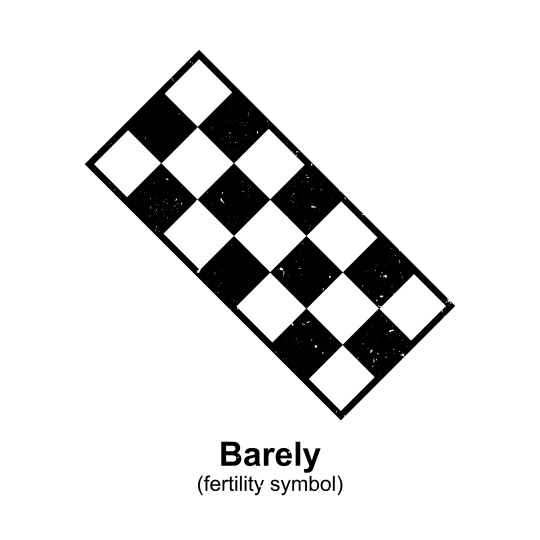



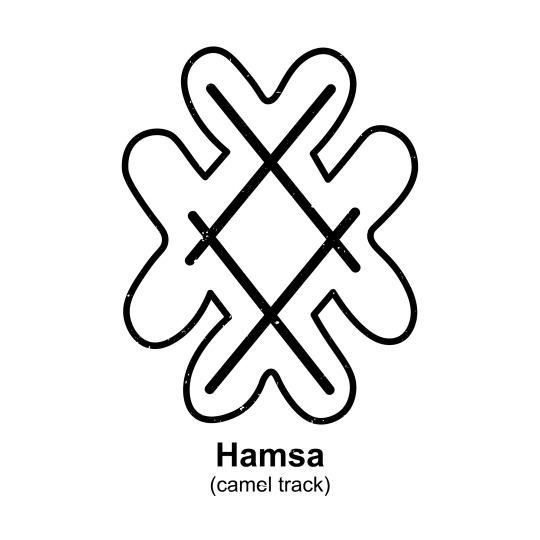

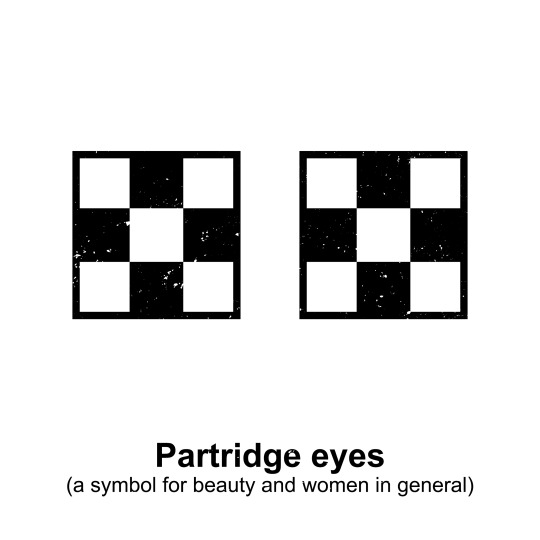

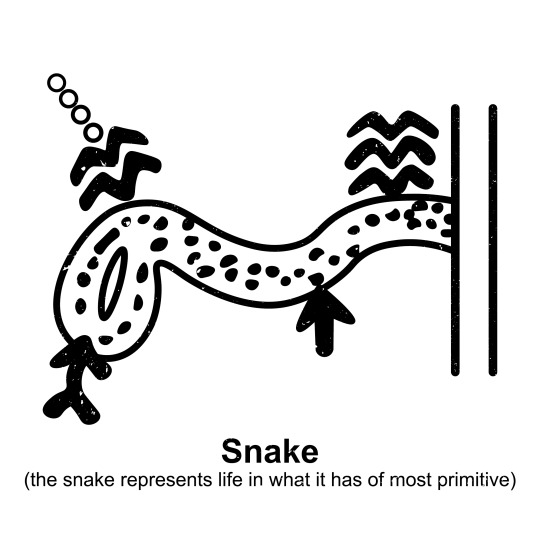
From “Berber Tattooing: Exploring Amazigh Tattoo Culture and Moroccan Women’s Face Tattoos”, illustrated by Mohammed Jiari
In recent times, there has been a renaissance of interest in Berber tattoos. Efforts to preserve and reinvigorate this ancient art form have borne fruit. Modern-day artists and tattoo enthusiasts explore the depths of Berber symbolism, infusing tradition with innovation to create contemporary designs that pay homage to the past.
This resurgence is not only about the art itself but also about nurturing cultural pride and identity among the Berber community. These timeless designs remain a vibrant and integral part of Berber heritage, ensuring that the symbolic meanings of Berber tattoos continue to thrive, enchanting and resonating with generations to come.



#africa#amazigh#berber#morocco#tattoo#tattoos#art#berber rug#Berber tattooing#maroc#marocco#berber tattoos#berber symbols#tattooing#kabyle#tribal tattoo#tribal art#african culture#african tribe#north africa#Berber Tattooing: in Morocco's Middle Atlas
36 notes
·
View notes
Note
top 5 soups and/or dumplings?
Thank you for the ask haha. If my legacy is soup or dumpling, I will not be upset at all!
Both of these are going to be in no particular order because i am asked to remember what i love and I immediately forget it.
TOP 5 DUMPLINGS
Xiaolongbao - I just love soup dumplings, ok? The way that you get that delicious burst of soup in your mouth as you bite in.... mmmm perfection.
Fish roe dumplings - just perfect in hotpot, if you haven't burnt your tongue on these at least once you haven't lived. I love them.
Jiaozi - if i have a bad day, i have a bag of frozen jiaozi in my freezer and i just boil them all and eat them with dipping sauce. My comfort food
Tangyuan - in my entirely correct and not at all biased opinino, black sesame tangyuan in sweet ginger soup is the best way to eat tangyuan
Siu mai - I have chosen one dim sum only, but tbh i could eat dim sum all the time forever if I had infinite money.
TOP 5 SOUPS
Pork rib and lotus root - the way that the pork just falls off the bone? The deepness of the broth??? the crunch of the lotus root?????? The only reason I don't eat this more often is because I can only get fresh lotus root for a few months each winter
Hot and sour - this has got me through SO MANY colds
Chicken noodle - the non-American noodles, which is to say lamian chinese noodles. Lots of ginger, star anise, and chilli....
Minnestrone - just a great way to eat all the vegetables. I love putting a parmesan rind in there to make it even more savoury
I don't know what it's called, but there's this spicy Moroccan lentil soup with preserved lemon in it which is AMAZING and i dream of it sometimes
4 notes
·
View notes
Text
Historic City of Meknes

Tucked between the Middle Atlas and the Rif Mountains, Meknes is a city where history whispers from every corner. Known as one of Morocco's four imperial cities, Meknes offers a blend of grandeur, culture, and charm that has earned it a place on the UNESCO World Heritage list since 1996. Walking through its gates feels like stepping back in time to an era of sultans, palaces, and towering walls. Let’s dive into the timeless allure of this extraordinary city!
Meknes rose to prominence in the 17th century under Sultan Moulay Ismail, a ruler with grand ambitions. Determined to make Meknes the heart of his empire, he transformed the city into a magnificent capital, building monumental gates, sprawling palaces, and imposing fortifications. His legacy is etched into every stone, making Meknes a living testament to Morocco’s imperial past.
One of Meknes’ most iconic landmarks is the Bab Mansour, often hailed as the most beautiful gate in Morocco. Completed in 1732, this monumental entrance is adorned with intricate zellige tilework, marble columns, and Kufic inscriptions. It served not only as a functional gateway but also as a statement of power and artistic brilliance. Stand beneath its arch, and you’ll feel the weight of history towering above.
Moulay Ismail's vision extended beyond palaces and mosques; he also built vast Royal Stables and Heri es-Souani, the granaries designed to store food for the city. These impressive structures could accommodate thousands of horses and hold massive supplies of grain, ensuring the empire's self-sufficiency. Walking through their cavernous interiors, you’ll marvel at the ingenuity that sustained a thriving imperial capital.

The Mausoleum of Moulay Ismail is a serene and sacred site, where the sultan himself rests. It’s one of the few religious places in Morocco open to non-Muslims. The mausoleum is a masterpiece of Moroccan design, with stunning stucco work, mosaic tiles, and serene courtyards. Visitors come to pay their respects and experience the tranquility of this hallowed space.
Located just outside Bab Mansour, El Hedim Square is Meknes' bustling hub. Once used for royal proclamations and public events, today it’s alive with street performers, market stalls, and cafés. As the sun sets, the square comes alive, offering a vibrant mix of sights, sounds, and flavors. Grab a mint tea and soak in the lively atmosphere—it’s an experience that captures the soul of Meknes.
Meknes is a city of walls, with an intricate network of fortifications stretching for over 40 kilometers. These walls, punctuated by grand gates and watchtowers, were designed to protect the imperial city and its treasures. Their sheer scale is awe-inspiring, a reminder of Moulay Ismail's vision of a city that would stand the test of time.
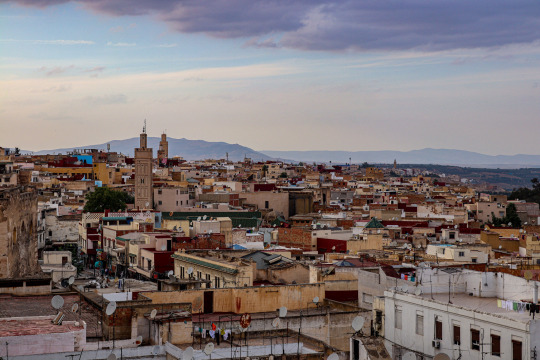
Meknes was inscribed as a UNESCO World Heritage Site for its exceptional testimony to the fusion of Islamic and European architectural influences. It stands as a symbol of Morocco’s imperial ambition and cultural richness. The city's preservation allows visitors to explore a well-preserved snapshot of 17th-century urban design and imperial grandeur.
While the historic core of Meknes is its main attraction, the surrounding area offers even more to explore. Just a short drive away, you’ll find the ancient Roman city of Volubilis and the sacred town of Moulay Idriss Zerhoun. Together, these sites paint a rich tapestry of Morocco’s historical and cultural layers.
Meknes is a city of contrasts: imperial yet approachable, grand yet intimate. It’s a place where history comes alive, and every corner tells a story. Have you wandered through its streets or stood in awe beneath Bab Mansour? Share your Meknes memories below!🏰✨🇲🇦
2 notes
·
View notes
Text
Henry Kissinger was Secretary of State for the US. His legacy is:
1. Organizing detente with China. Which would lead to normalized relations with China leading to the China of today, which depending on where you live today might either make you happy, sad, concern, or furious.
2. Advocating for the unrestricted bombing in Cambodia to stop the Vietcong from using the Ho Chi Minh trail, a complete fucking war crime as Cambodia was not involved, was at peace with the US and had little to do with Vietnam. This laid the groundwork for an upswell of support for the Khmer Rouge, who then went on to commit genocide. Even after the genocide, Kissinger advocated for friendship with the Khmer Rouge, as they were more aligned with Beijing than Moscow.
3. He supported Pakistani military dictators and generals against Bengal's war of independence. The Pakistanis were committing what has been called "selective genocide".
4. He worked towards detente with the USSR and Brezhnev, including SALT 1, aimed at limiting nuclear proliferation.
5. Kissinger didn't tell Nixon immediately about the outbreak of the Yom Kippur war, as he worried Nixon would get involved before the situation would be beneficial to Israel.
6. Kissinger was a key player in having Allende assassinated in Chile, replacing him with the right-wing dictator and murderous bastard, Augusto Pinochet.
7. He supported the Argentinian Junta for couping Isabella Peron, who had won her democratic election. This junta would go on to murder and disappear tens of thousands, culminating in the Falklands war.
8. Kissinger was a proponent of Brazil getting a nuclear weapons program, mainly because it was a right-wing junta in power.
9. Kissinger publicly engaged in talks with Rhodesia to put an end to the war, and transition to black majority rule. Privately, he told the racist, apartheid loving Ian Smith that he admired him.
10. Following the breakdown of Estado in Portugal (Salazzar's dictatorship), decolonization started for what remained of the Portuguese empire. One of those was East Timor. Sudharta, Indonesia's military ruler, decided he would annex the territory, and damn the wants and desires of local East Timorans. Kissinger supported the Indonesian president, in an on-going occupation that has killed many, many tens of thousands. It's possibly worse and more brutal than the Israeli occupation of West Bank, but no one cares.
11. West Sahara, a problem area to this day, was forcibly conceded away from Spain. Kissinger supported passing this territory, despite the locals desire for independence, and didn't inform President Ford about an upcoming Moroccan invasion. Another whoopsie moment, I guess.
12. Aided in behind-the-back talks with Vietcong forces to keep the Vietnam War going, sabotaging peace talks with Johnson and South Viet government which prolonged the War another five years (!) until Nixon could conveniently end the war. As well as Operation Menu and Operation Freedom Deal, Vietnam War era atrocities ordered by Nixon and Kissinger to bomb the ever-loving shit out of Cambodia, with an estimated 55,000-150,000 civilian deaths and causing a massive refugee crisis, and to this day the soil in that region of Cambodia is thick with unexploded bombs.
Via Reddit, u/JustMyOpinionz
13 notes
·
View notes
Text
My Journey with Moroccan Rugs: A Touch of Tradition
When I first discovered Moroccan rugs, I knew they were more than just decor—they were rich with history and artistry. I began exploring Berber rugs, which are handcrafted by Moroccan tribes. What fascinated me most was the deep cultural meaning behind the patterns. Every pattern Berber carpet reflects a personal story or tribal tradition, which makes each rug unique and full of life.

While searching for the perfect addition to my home, I came across vintage Moroccan carpets. These older pieces, worn by time, felt like they carried stories from past generations. I found myself drawn to their authenticity and the idea of owning something with a history.
Eventually, I chose an abstract Moroccan rug that blended modern design with traditional craftsmanship. The bold, artistic patterns gave it a contemporary feel, yet it still held the essence of Moroccan culture. The use of natural wool and plant-based dyes in the rug’s creation made it both eco-friendly and durable—qualities I really appreciate.
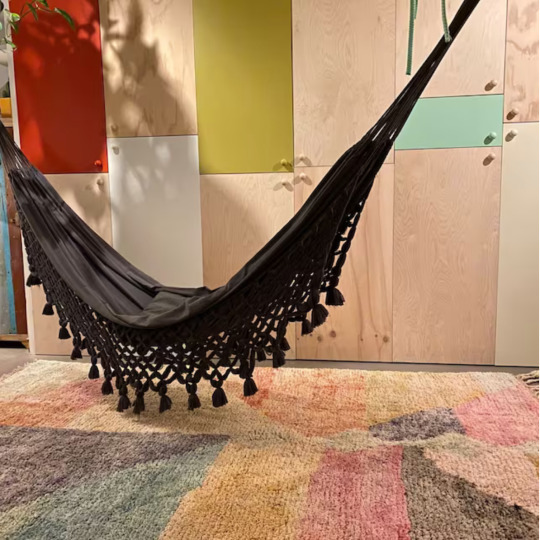
Owning a Moroccan rug has transformed my living space. It adds warmth, character, and a connection to a rich cultural heritage. It’s more than just a beautiful piece on my floor—it’s a symbol of tradition and skilled craftsmanship.
If you’re considering a Berber rug, I highly recommend it. It’s not just about style; it’s about bringing a piece of Morocco’s artistic legacy into your home, and I promise, you’ll feel the difference it makes.
2 notes
·
View notes
Text
The stories we share and the legacy of food
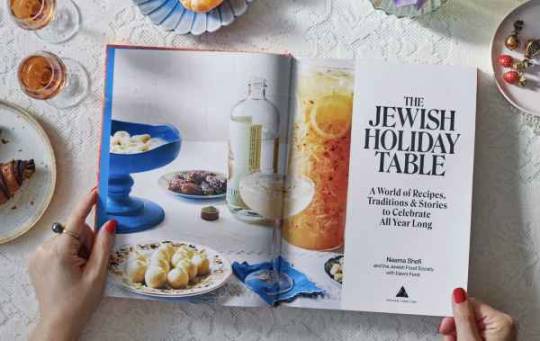
Throughout the history of the Jewish people, food has served as a bridge between their ancient heritage and the present day, as Daniela Ghelman explains in the Boca Raton Observer.
Culinary Curator and Jewish and Israeli Food Specialist Naama Shefi’s latest cookbook, “The Jewish Holiday Table: A World of Recipes, Traditions & Stories To Celebrate All Year Long,” highlights this connection exceptionally well.
Hailing from Givat HaShlosha, a small kibbutz in central Israel, Shefi arrived in New York City in 2005, following a career path in film. While navigating the bustling pace of her new life in America, she turned to food to reconnect and strengthen her Jewish identity.
She began organizing various culinary events across the city, such as gefilte fish conferences, an Israeli Moroccan Seder and an Iraqi Jewish comfort food pop-up. These projects paved the way for the Jewish Food Society, a nonprofit that Shefi founded in 2017 that preserves, celebrates and revitalizes Jewish culinary heritage.
“Following the success of launching many delicious Jewish food events across the city, I started to imagine a home for Jewish food,” says Shefi, 43, of the nonprofit. A great inspiration was her husband’s grandmother, Nonna, who Shefi says opened her eyes to the connectivity, hospitality and spirit around the Shabbat table.
“I thought back to Nonna and realized there are countless cooks like her whose recipes tell the stories not only of their lives and those before them but also of their communities and Jewish experience. I knew that if those recipes disappeared, so would a crucial and irreplaceable part of our history and culture.”
#manchester#iraq#iraqi#london#baghdad#uk#liverpool#hussein al-alak#scotland#usa#jewish history#judaism#culture#art#food#food photography#desserts#recipe#bread#baking
2 notes
·
View notes
Text
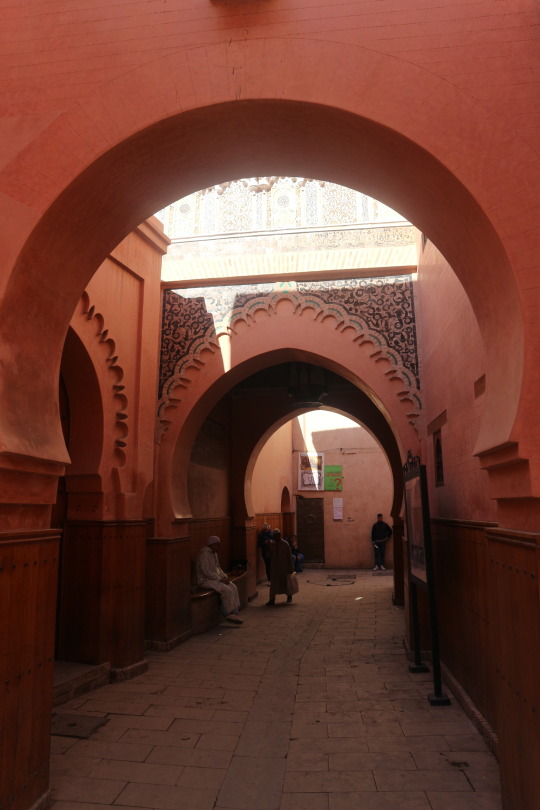

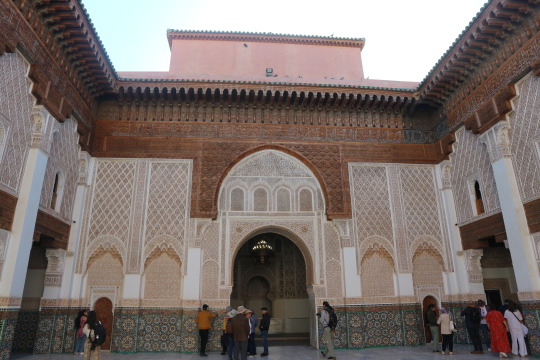
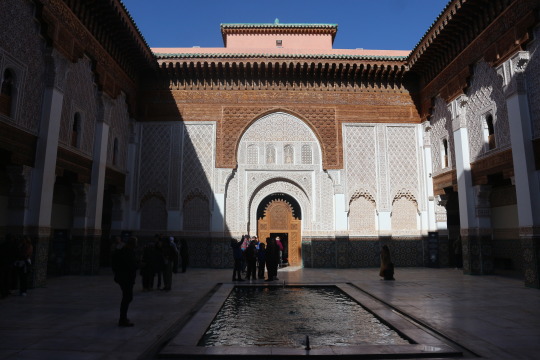
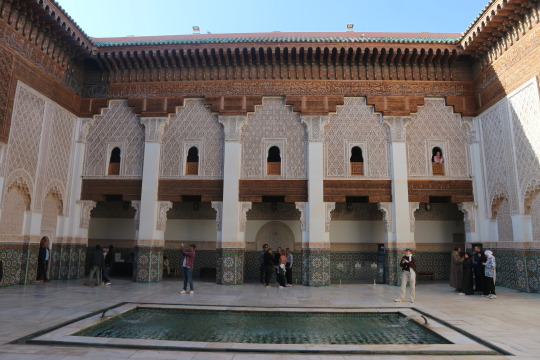
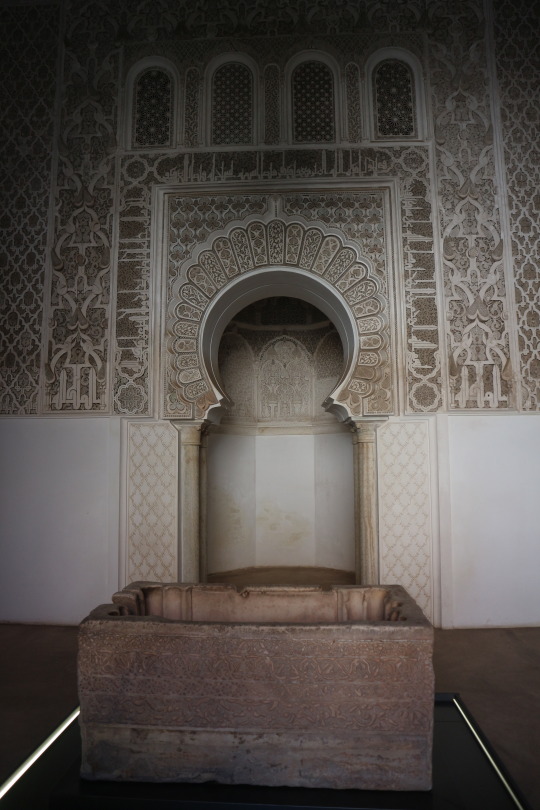
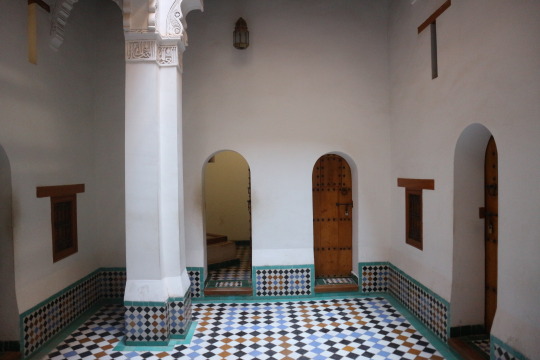
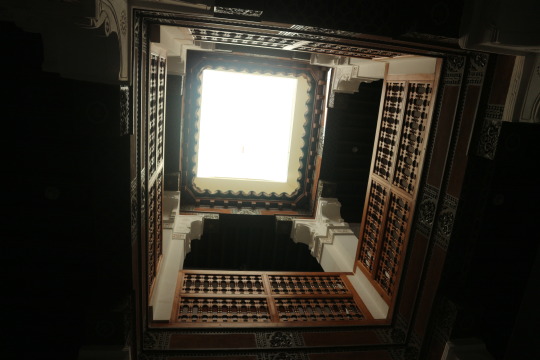
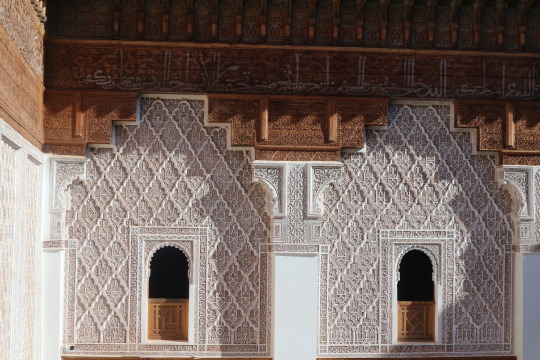

اللَّهُمَّ افْتَحْ لِي أَبْوَابَ رَحْمَتِكَ
The seventh and last part of my Morocco series (please see here, here, here, here, here and here for more).
Marrakech became the capital city of an empire spanning Africa and Europe when it was founded by the Almoravid dynasty in 1070 and Islam, which has been the foremost religion (alongside a large Jewish minority) since Morocco was conquered by the Arabs in 709 AD, has always set the tone of the city.
Ben Youssef Mosque was built here by Ali ibn Yusuf (1106-1142 AD), who was an Almoravid, and the site is now home to Ben Youssef Madrasa since 1565.
A madrasa, or theological school, has been here since Abu Al Hasan ibn Othman of the Marninid Dynasty (1244-1465) founded it between 1331 and 1348 and this building has stood since commissioned by Abdallah Al Ghalib of the Saadian dynasty (1549-1659), who also built palaces and tombs that you can read about in my other posts.
(This is mainly a post about the 16th and 17th centuries; please see here and here for earlier and later eras).
The Saadians were sharifs (descendants of Mohammed, the founder of Islam, or his family) and thus felt a duty that they took seriously, and carried out well, as you can see from what they left behind.
They were also mindful of the links to Europe which their country had had since European times, and which has left its mark in Morocco since the Koutoubia Mosque, built 1147 AD by the Almohad dynastY, who overthrew the Almoravids earlier that year. (The Koutoubia is twinned with a mosque in Cordoba, in what is now Spain, which sounds absolutely lush, though I’ve never been there).
As the Museum with No Frontiers points out, “if anything can be singled out as the leitmotif running through the area of the Mediterranean, it is diversity of expression combined with the harmony of sentiment, a sentiment more cultural than religious”. I’d love to test this out in Cordoba or Seville one day!
Indeed the Andalusi marble basin, built in 1002-1007 AD, went from Morocco to Cordoba and came back; it now lives here as a sign of those who came here after 1492, when the last Muslim power in what is now Spain was cast out.
At that time, all Muslims and Jews were expelled from the Spanish state, and many came here, as it was the nearest friendly country and many of their forefathers came from Morocco; they were just as much European as Islamic and African, and brought back a legacy that infuses all Saadian and later buildings.
Because the state religion was (and is) Islam, both theologians and lawyers were trained in a madrasa that taught 800 students and was thereby the largest in Morocco.
This school worked tirelessly until it was shut down in 1960; it then reopened as a museum in 1982 and was restored between 2018 and 2022 on the orders of King Mohammed VI, showing the links between religion of state that have always existed in Morocco, though without becoming an Iranian-style theocracy.
Since it was built just after a wave of migration from Europe to Morocco, and has strong European influences painted on to the Islamic bedrock (both Arabic and that of the Berber folk who have always lived here), this shows the sheer Moroccan-ness that makes Morocco distinctive.
فِى بُيُوتٍ أَذِنَ ٱللَّهُ أَن تُرْفَعَ وَيُذْكَرَ فِيهَا ٱسْمُهُۥ يُسَبِّحُ لَهُۥ فِيهَا بِٱلْغُدُوِّ وَٱلْـَٔاصَالِ
2 notes
·
View notes
Text
Elegance Redefined: Mother of Pearl Dining Table Collection | OneDeersLane
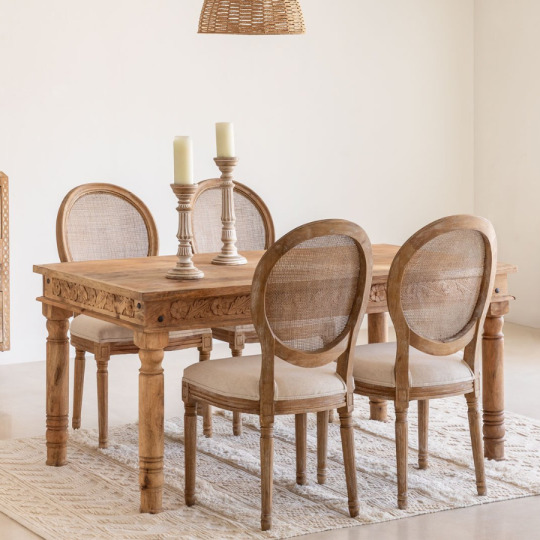
Timeless Luxury for Your Dining Space
When it comes to luxurious home décor, few materials rival the timeless beauty of Mother of Pearl. At OneDeersLane, our Mother of Pearl Dining Table Collection is crafted for those who appreciate artistry, elegance, and cultural richness in every corner of their home. Each dining table tells a story—handcrafted with intricate inlay work that transforms everyday meals into regal experiences.
Explore our Mother of Pearl Dining Tables and discover why these pieces are not just furniture—they are legacy.
Why Choose a Mother of Pearl Dining Table?
Natural Beauty with a Subtle Iridescence
Mother of Pearl, also known as nacre, is an organic-inorganic composite material produced by mollusks. Its natural shimmer, delicate coloring, and unique textures make it a coveted choice for luxury furniture. A Mother of Pearl dining table brings depth, charm, and a distinctive sparkle to your dining area.
Cultural Craftsmanship with Modern Appeal
Handcrafted by skilled artisans, our dining tables are not mass-produced. Each piece involves hours—even days—of intricate inlay work, often drawing inspiration from Mughal, Moroccan, and Rajasthani design elements. The result is a harmonious blend of traditional art and modern luxury.
Key Features of Our Mother of Pearl Dining Tables
Exquisite Inlay Work
Every mother of pearl dining table from OneDeersLane is a masterpiece of hand-inlaid craftsmanship. The delicate shell pieces are embedded into wooden surfaces to form mesmerizing patterns—floral motifs, geometric borders, or nature-inspired themes.
Premium Wood Base
To ensure longevity and sturdiness, each table is built with seasoned hardwoods like mango wood or sheesham, offering structural strength while highlighting the intricate overlay.
One-of-a-Kind Finishes
No two tables are exactly alike. The natural variations in shell tones—from milky white and cream to blush pinks and light greys—mean your table will have a truly bespoke finish.
Eco-Friendly & Handcrafted
Sourced responsibly and made with zero automation, these tables represent sustainable luxury. They support traditional artisans and promote eco-conscious consumerism.
Styling Your Mother of Pearl Dining Table
A mother of pearl table deserves a setting that complements its opulence without overpowering it.
Minimalist or Maximalist – It Fits All
Pair it with neutral-toned upholstered chairs for a subtle contrast, or go bold with velvet seating and brass accents. Whether your taste is modern, bohemian, or traditional, these tables offer unmatched versatility.
Ideal for Every Occasion
From intimate dinners to festive gatherings, a mother of pearl dining table sets the stage for memorable meals. Add soft candle lighting or pendant chandeliers above it, and you've curated the perfect ambience.
Caring for Your Mother of Pearl Table
Maintaining the beauty of your mother of pearl dining table is easy with a few mindful practices:
Use a soft cloth for regular cleaning—avoid abrasive cleaners.
Protect the surface from prolonged exposure to moisture or direct heat.
Always use placemats or coasters to preserve the finish.
With minimal care, your table can last for generations while retaining its luminous glow.
Customization Available at OneDeersLane
We understand that every home is unique. That’s why we offer customization options:
Choose your preferred dimensions, inlay designs, and wood finishes
Work with our in-house designers for tailored concepts
Available in round, rectangular, and oval shapes
Whether it’s for a cozy breakfast nook or a grand dining hall, we can create a piece that perfectly fits your space.
1 note
·
View note